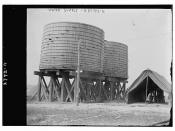Detailed paper about the risks and benifits of community water fluoridation -
In 1931 at the University of Arizona Agricultural Experiment Station M. C. Smith, E. M.
Lantz, and H. V. Smith discovered that when given drinking water supplied with fluorine,
rats would develop tooth defects. Further testing by H. T. Dean and E. Elove of the
United States Public Health Service confirmed this report, and stated that what is known
as mottled tooth. Mottled tooth is a condition in which white spots develop on the back
teeth. Gradually the white spots get darker and darker until the tooth is eroded
completely. This was believed to be caused by fluorine in drinking water (Behrman pg.
181).
A strong uproar was heard when this was released and people wanted all fluorine
out of their water. But later tests concluded that communities with high levels of fluorine
in their drinking water suffered less dental cavities.
Further testing concluded that at least
1.0 parts per million of fluorine could help to prevent cavities, but more than 1.5 PPM
would cause mottled tooth, so basically a little fluorine would be okay but a lot of fluorine
would be bad (Behrman 182).
In 1938, with this information, Dr. Gerald Cox of the Mellon Institute began to
promote the addition of fluoride to public water systems, claiming that it would reduce
tooth decay, however there were two major obstacles in his path, The American Medical
Association, and The American Dental Association. Both associations wrote articles in
their journals about the dangers of fluoridation of water supplies. The American Dental
Association wrote the following in the October 1, 1944 issue: "We do know the use of
drinking water containing as little as 1.2 to 3.0 parts per million of fluorine will cause such
developmental disturbances in bones...


